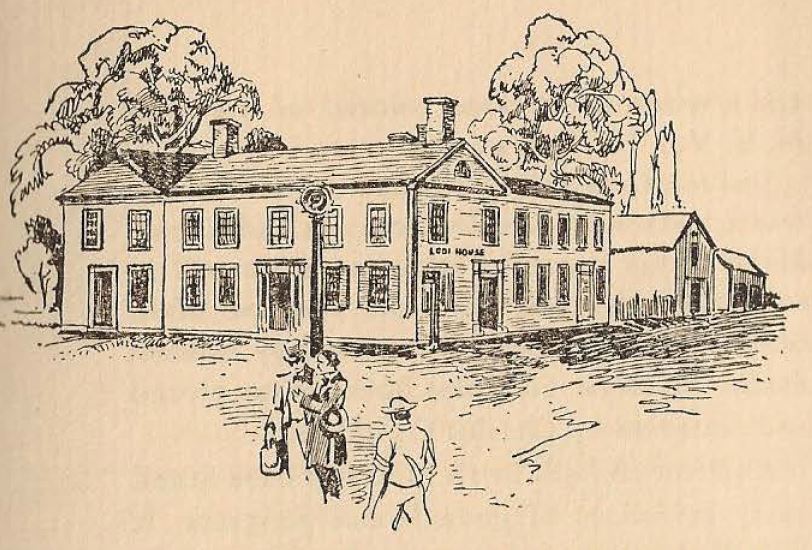
next term of three months was taught by Chester Howe, at $6.00 per month. Chester Howe was one of a family of ten children. Chester had an illness in his twelfth year that left him enfeebled in health and with a curvature of the spine. With these handicaps, and very limited advantages for educati on, he was enabled by his own exertions and his inborn worth to take first rank in his profession. He attended the common school and had |
two terms at the Fred·onia Academy. In 1829 he entered as a student in the law office of Albert G.Burke of Lodi. In 1833, he was admitted to the bar and _in 18 3 5 opened his law office in Lodi. In July, 1829, Samuel T. Munger came to Lodi and engaged in the tanning and show business in connection with Nathaniel Frank, under the name of Frank & Munger. Thus the start of Gowanda's important tanning industry was made well over a century ago. Later Gideon Webster purchased the interest of Mr. Frank and the firm became Munger and Webster. The partners carried on the business witl1 success and did a large volume for those early days. In 1839, Mr. Munger retired from the mercantile business and bought a farm one mile east of the village in the Rosenberg district. While in Lodi Mr. Munger and family lived on Perry Street, one of his sons being S. Clark Munger, who later lived on the old homestead in the Rosenberg district and was one of the distinctive characters of the community. |
|
Page Twenty-seven |
|
|
The bridge built at Hidi by Ahaz Allen, in 1816, was condemned in 1830 as unsafe and was torn down, never to be re·built. The new bridge in Lodi was used exclusively, and this was responsible for a change in the pioneer route through Lodi. Instead of crossing the bridge at Hidi and coming down old Water Street to the village, the Zoar Road was continued west to connect with East Main Street, thence over the bridge, down Water Street, or up West Main Street to the Maltbie-Sisson Hill or up Cooper's Hill (Perrysburg Hill) on westward to Perrysburg which had been settled about 1815-1817. ·In 1830, Thomas J. Parker of Hamburg, N. Y., came to Lodi and worked as an apprentice to his brother, Francis B. Parker who was a tailor. After three years Thomas assumed the business, bought land on Water Street south of the bridge and carried on the business until |
1861 when he became colonel of the 64tl1 N. Y. Vol. Inf. and went to war. Joshiah Cass came to Lodi at this time. He was a weaver of coverlets, carpets and linens. Many of his beautiful bedspreads are still in existence. His first location was on Main Street at the point now intersected by Aldrich Street. Later he built the house now owned and occupied by Charles Congdon .A visitor to Lodi in 1830 would have found many evidences of growth and progress. It thien l1ad a population of some 200 people, , four stores, five taverns, one newspaper, , a school, a doctor, a lawyer, a b.r;idge and a Cemetery. It.was makin,g good use of the water power of the Cattaraugus and-probably most i1nportant of all-it had the kind of leading citizens to carry it forward to increasing size and importance. |
|
Page Twenty-eight |
|
Pace of Progress
|
THE decade from 1830 to 1840 was a period of consistent and, at times, rapid growth. The population nearly doubled in those ten years. Yet its size in 1840 was just about one tenth of the Gowanda of today .. It was a period of home building and many structures of that time are still standing ·and in use. One house in Gowanda well past the century mark is the old Plumb home. It stands the second house north from Perry Street on the east side of Buffalo Street, small, quaint and old. It was built by Joseph Plumb, Sr., adjacent to the Plumb store, probably sometime in 1827 or shortly after. Previous to the coming of the Plumbs, |
Turner Aldrich gave each of his sons and daughters a tract of land. Merrill was given the land south of the creek, later known ·as the Slocum farm. · The residence of the late Mrs. William Wilber on Chestnut Street was known as the Slocum house and the Green Parrot Inn, the property of Ralph Sc·haack, was also occupied by one of the Slocum family. The Wilber Home has hand-hewn walnut beams and frame, and is well over a hundred years old. Built when families were large and the farmer boarded his ''hired help'', the house contained so many rooms that it has been converted into a three-family apartment. Turner Aldrich gave his son Isaac a tract |
|
Page Twenty-nine |
|